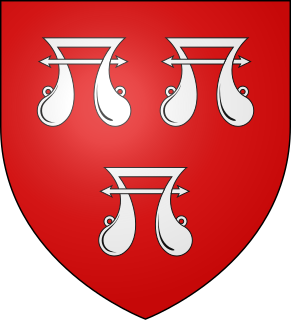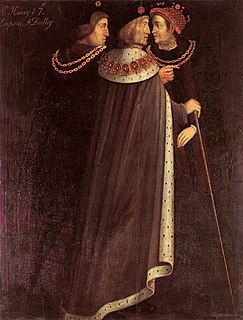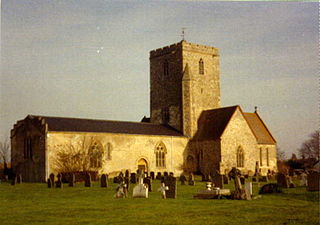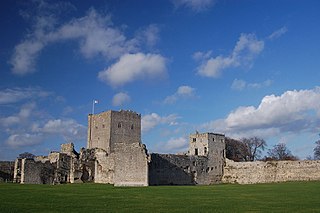Related Research Articles

William Hastings, 1st Baron Hastings KG was an English nobleman. A loyal follower of the House of York during the Wars of the Roses, he became a close friend and one of the most important courtiers of King Edward IV, whom he served as Lord Chamberlain. At the time of Edward's death he was one of the most powerful and richest men in England. He was executed following accusations of treason by Edward's brother and ultimate successor, Richard III. The date of his death is disputed; early histories give 13 June, which is the traditional date.

Thomas Ros or Roos, 8th Baron Ros of Helmsley was an English peer.

Sir Richard Empson, minister of Henry VII, was a son of Peter Empson. Educated as a lawyer, he soon attained considerable success in his profession, and in 1491 was a Knight of the shire for Northamptonshire in Parliament, and Speaker of the House of Commons.

Reginald West, 6th Baron De La Warr and 3rd Baron West was an English nobleman and politician.

Cholsey is a village and civil parish 2 miles (3 km) south of Wallingford in South Oxfordshire. In 1974 it was transferred from Berkshire to Oxfordshire, and from Wallingford Rural District to the district of South Oxfordshire. The 2011 Census recorded Cholsey's parish population as 3,457. Cholsey's parish boundaries, some 17 miles (27 km) long, reach from the edge of Wallingford into the Berkshire Downs. The village green is called "The Forty" and has a substantial and ancient walnut tree.

The Southampton Plot was a conspiracy to depose King Henry V of England, revealed in 1415 just as the king was about to sail on campaign to France as part of the Hundred Years' War. The plan was to replace him with Edmund Mortimer, 5th Earl of March.

Sir Thomas Grey, of Heaton Castle in the parish of Norham, Northumberland, was one of the three conspirators in the failed Southampton Plot against King Henry V in 1415, for which he was executed.

Wallingford Castle was a major medieval castle situated in Wallingford in the English county of Oxfordshire, adjacent to the River Thames. Established in the 11th century as a motte-and-bailey design within an Anglo-Saxon burgh, it grew to become what historian Nicholas Brooks has described as "one of the most powerful royal castles of the 12th and 13th centuries". Held for the Empress Matilda during the civil war years of the Anarchy, it survived multiple sieges and was never taken. Over the next two centuries it became a luxurious castle, used by royalty and their immediate family. After being abandoned as a royal residence by Henry VIII, the castle fell into decline. Refortified during the English Civil War, it was eventually slighted, i.e. deliberately destroyed, after being captured by Parliamentary forces after a long siege. The site was subsequently left relatively undeveloped, and the limited remains of the castle walls and the considerable earthworks are now open to the public.

John Clifford, 9th Baron Clifford, 9th Lord of Skipton was a Lancastrian military leader during the Wars of the Roses in England. The Clifford family was one of the most prominent families among the northern English nobility of the fifteenth century, and by the marriages of his sisters John Clifford had links to some very important families of the time, including the earls of Devon. He was orphaned at twenty years of age when his father was slain by partisans of the House of York at the first battle of the Wars of the Roses, the Battle of St Albans in 1455. It was probably as a result of his father's death there that Clifford became one of the strongest supporters of Queen Margaret of Anjou, consort of King Henry VI, who ended up as effective leader of the Lancastrian faction.

Aubrey de Vere, 10th Earl of Oxford was the third son of John de Vere, 7th Earl of Oxford and Maud de Badlesmere, daughter of Bartholomew de Badlesmere, 1st Lord Badlesmere.

Philippa de Mohun was Duchess of York, as a result of her third marriage to Edward of Norwich, 2nd Duke of York (c.1373–1415), Lord of the Isle of Wight, a grandson of King Edward III (1327–1377). She succeeded her third husband as Lady of the Isle of Wight (1415–1431).

Thomas Clifford, 8th Baron de Clifford, also 8th Lord of Skipton, was the elder son of John, 7th Baron de Clifford, and Elizabeth Percy, daughter of Henry "Hotspur" Percy and Elizabeth Mortimer.

Anne Hastings, Countess of Huntingdon was an English noble. She was the daughter of Henry Stafford, 2nd Duke of Buckingham, and Lady Katherine Woodville. She was the wife of Sir Walter Herbert, and George Hastings, 1st Earl of Huntingdon, and served in the household of King Henry VIII's daughter, the future Queen Mary I.
George Hastings, 1st Earl of Huntingdon was an English nobleman.

Sir John Courtenay was the third son of Thomas Courtenay, 13th Earl of Devon, and Margaret Beaufort, and was styled Earl of Devon by Lancastrians in exile, following the execution of his brother the 14th earl in 1461.
William Grey was Bishop of London and then Bishop of Lincoln.

Margaret de Bohun, Countess of Devon was the granddaughter of King Edward I and Eleanor of Castile, and the wife of Hugh Courtenay, 10th Earl of Devon (1303–1377). Her seventeen children included an Archbishop of Canterbury and six knights, of whom two were founder knights of the Order of the Garter. Unlike most women of her day, she received a classical education and was a lifelong scholar and collector of books.
Ralph Neville, 3rd Earl of Westmorland was an English peer. He was the grandfather of Ralph Neville, 4th Earl of Westmorland.

Thomas Courtenay, 6th/14th Earl of Devon, was the eldest son of Thomas de Courtenay, 5th/13th Earl of Devon, by his wife Margaret Beaufort, the daughter of John Beaufort, 1st Earl of Somerset, and Margaret Holland, daughter of Thomas Holland, 2nd Earl of Kent. Through his mother he was a great great-grandson of King Edward III. The ordinal number given to the early Courtenay Earls of Devon depends on whether the earldom is deemed a new creation by the letters patent granted 22 February 1334/5 or whether it is deemed a restitution of the old dignity of the de Redvers family. Authorities differ in their opinions, and thus alternative ordinal numbers exist, given here.

The siege of Oxford took place during The Anarchy—a period of civil war following the death of Henry I of England without an heir—in 1142. Fought between his nephew, Stephen of Blois, and his daughter, the Empress Matilda, who had recently been expelled from her base in Westminster and chosen the City of Oxford as her new headquarters. Oxford by now was effectively a regional capital and important in its own right. It was a well-defended city with both rivers and walls protecting it, and was also strategically important as it was at a crossroads between the north, south-east and west of England, and also not far from London.
References
- ↑ Ditchfield and Page, p. 51
- ↑ Prestwich p. 47
- ↑ Lysons and Lysons, p. 394
- ↑ Richardson and Everingham (2005) p. 71
- ↑ Richardson and Everingham (2004) p. 94
- ↑ Crouch, p. 23
- ↑ Hedges v.1, p 324
- ↑ Beardwood
- ↑ Hedges v. i. p. 346
- ↑ Hedges
- ↑ Richardson and Everingham (2005) p. 313
- ↑ Hookham
- ↑ Arn
- ↑ Great Britain Public Record Office, 4,p. 216
- ↑ Hedges v.2, p. 151
- ↑ Howell, p. 949
- Arn, M.J. (Ed.) (2000) Charles of Orléans in England (1415-1440), Brewer, Cambridge, MA, USA
- Beardwood, A. (1964) The trial of Walter Langton, Bishop of Lichfield, 1307-1312 American Philosophical Society.
- Crouch, D. (2008) The Beaumont Twins: The Roots and Branches of Power in the Twelfth Century. Cambridge University Press, Cambridge, UK.
- Ditchfield, P.H; Page, W. (Eds) (1907) Houses of Benedictine monks: The abbey of Abingdon In A History of the County of Berkshire: Volume 2 pp. 51–62. Accessed: 15 June 2011
- Great Britain Public Record Office (1650) Calendar Of State Papers, Domestic Series
- Hedges, J.K. (1881) The History of Wallingford, in the County of Berks. Wm Clowes, London, 2 vol.Hedges p 324 vol 1
- Hookham, M.A. (1872) The life and times of Margaret of Anjou, queen of England and France: and of her father René "the Good", king of Sicily, Naples, and Jerusalem. With memoirs of the houses of Anjou, Volume 2. Tinsley Brothers
- Howell, T. B. (1816) A complete collection of state trials and proceedings for high treason and other crimes and misdemeanours from the earliest period to the year 1783. Volume 4. Hansard, London, UK.
- Lysons, D. ; Lysons. S (1813) Magna Britannia: Bedfordshire, Berkshire, and Buckinghamshire. Cadel & Davies, London, UK.
- Prestwich, M. (1988) Edward I. University of California Press, 1988, Berkeley, CA, USA.
- Richardson, D., Everingham, K.G. (2005) Magna Carta ancestry: a study in colonial and medieval families. Genealogical Publishing Company, Baltimore, Maryland, USA.
- Richardson, D., Everingham, K.G. (2004) Plantagenet Ancestry a study in colonial and medieval families. Genealogical Publishing Company, Baltimore, Maryland, USA.
